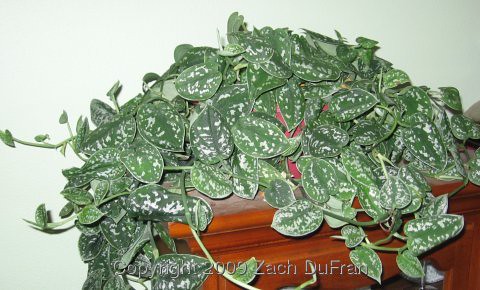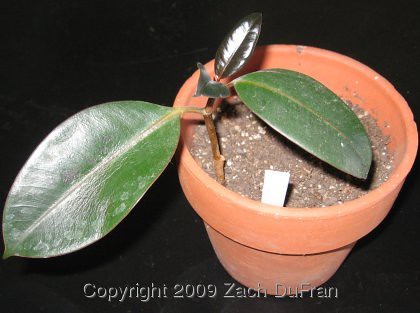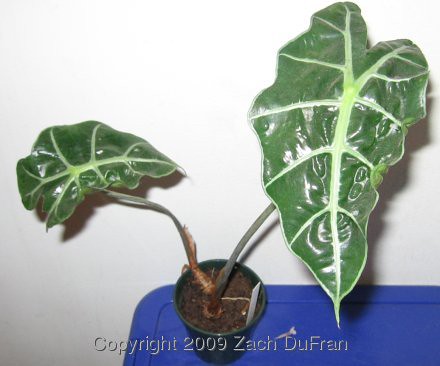I like to grow all kinds of different plants. Some plants I pick for their foliage, others for their blooms, and still others for their unusual appearance. Some plants thrive in my care and some others don't. Occasionally some even die. Whether it was my fault or simply a plant destined to death because of an unseen illness when I purchased it.
Every plant deserves a second chance, right? [With the exception of Coconut palms. I don't think I can ever grow one of those things.]
I have given quite a few plant species second chances in my care. Last week I posted about my Philodendron 'Xanadu', which is just one species of plant I gave a second chance. The first 'Xanadu' I purchased died about a month after I purchased it. My second seems on it's way to a long and happy life in my care.
This post is about three particular plants that survived when given a second chance.
Scindapsus pictus - Silver pothos, Satin pothos
This is one of my very favorite plants is it's on my 2nd chance list! How about that? Actually, this plant would be one of my very favorites even if I had to give it a thousand chances and never succeeded in growing it. It's just one of the most beautiful plants I've ever seen and no amount of struggle in growing it would ever dampen my admiration. Thankfully, I haven't struggled too much to grow this one. I just had a bad first experience with the plant.
Many small houseplants are put in stores mere days after being potted. That's right, most houseplants are grown in big factories where they place cuttings in hydroponic chambers and force roots to develop. When I bought my first Scindapsus pictus, I promptly repotted it when I got home. I think it is possible that I tried to repot the plant when it still had rather immature roots. The roots that grow in water have to adjust to actual soil conditions once they are transplanted. The trauma of two transplants within a couple of days might have been enough to do this plant in. The other problem was that I probably didn't have the plant in enough light. I'm sure it was being grown in a greenhouse in Florida. Believe it or not, a greenhouse in Florida receives more light than a shady windowsill in Oklahoma. That's just how it goes.
Now that I have given the plant a second chance, I have a really nice specimen that has been growing at my desk at work for about a year and a half now. I have taken some clippings from my office plant and potted them in a pot with a stake, hoping to train the plant to climb the stake. About a month ago, I bought a large hanging Scindapsus for home. It's the plant pictured above.
Ficus elastica 'Burgundy' - Burgundy Rubber Plant
I bought a small burgundy rubber plant a couple of years ago. I think there were 3 or 4 stems in a small 4" pot. I knew that they were fairly common houseplants and therefore probably not very hard to grow. I expected mine to get large and so I repotted my little plant in a much larger pot shortly after I got it. I didn't know at the time, but this is not a good idea. Ideally a plant should be in a pot that is about 1-2 inches wider than the plant's root span. Most people understand that when you water your plant, the roots absorb the water from the soil. But what I didn't realize is that when you repot a plant in pot that is much wider than the root span, the roots will not absorb the water in much of the soil and the soil will stay wet much longer. I'm almost certain that this is what happened to my first rubber plant, which showed signs of root rot before dying.
The second time around, I purchased one single little stem in a tiny pot. How can you not take a chance on an attractive $2 plant?
This time around, I have kept my single stem in a small pot. I have had to resist the temptation to pot several plants in larger pots, having learned from my experience with the rubber plant (and a couple of others that had the same problem). After a month or two of stagnancy, my rubber plant has finally starting producing some new leaves. This is exciting because the new leaves are very glossy and dark red. Over time the leaves thicken and deepen into that unique color of purple green.
There are some large specimens of this plant in the hallways of my office building that I enjoy looking at each time I have to go upstairs.
The Ficus genus is an interesting group of trees, ranging from the small, very common Ficus benjamina houseplant tree and all of the fig trees to the unique rubber tree and the gigantic Banyan tree (Ficus benghalensis). There are some Banyan trees that cover acres. One such famous tree is located in Lahaina, Maui, Hawaii. Another one is located at the Indian Botanic Garden. I will be visiting the Hawaiian Banyan tree this Spring and will hopefully have some pictures to post here.
Alocasia amazonica - African Mask
I had one of these plants probably about 8 years ago. I can't even remember how long I kept it alive or how it died. I remember seeing it for the first time in a little houseplant store that opened on Main Street here in town. My first reaction was that it reminded me of a Pterodactyl. For some reason, the store had decided to start a plant business and buy about 100 of each of 3 different plants. I'm not kidding - they had about 100 pots of 3 different plants (4 at most). At least, that's how I remember it. One of the plants they had decided to sell was Alocasia amazonica. I'm not sure what their business plan was. I guess it was to turn everyone in town into a fan of those three species. Needless to say, the store didn't last very long. Unfortunately, neither did my plant. The two events were unrelated. At the time I wasn't all that interested in plants and I think mine just got neglected.
Since then my plant habits have changed quite a bit. I'm more likely to overcare for a plant now than to ignore one. I bought a small pot with two Alocasia amazonica bulbs/stems just a couple of months ago. My plant hasn't changed much - just grown taller - but I don't seem to be having any trouble keeping this one alive. I imagine this summer my plant might produce a couple more bulbs and leaves whenever it is in happier growing conditions. One of the two stems sort of collapsed recently, but it has been growing okay with a thin dowel rod as support.
Alocasias are from the Aroid family, of which I am a collector. They are pretty closely related to Colocasias (another Aroid genus), which are the plants commonly called "Elephant Ears." There are approximately 70 species of Alocasias and quite a few cultivars. They are grown for their stunning, and often very glossy, foliage.
Every plant deserves a second chance, right? [With the exception of Coconut palms. I don't think I can ever grow one of those things.]
I have given quite a few plant species second chances in my care. Last week I posted about my Philodendron 'Xanadu', which is just one species of plant I gave a second chance. The first 'Xanadu' I purchased died about a month after I purchased it. My second seems on it's way to a long and happy life in my care.
This post is about three particular plants that survived when given a second chance.
Scindapsus pictus - Silver pothos, Satin pothos
This is one of my very favorite plants is it's on my 2nd chance list! How about that? Actually, this plant would be one of my very favorites even if I had to give it a thousand chances and never succeeded in growing it. It's just one of the most beautiful plants I've ever seen and no amount of struggle in growing it would ever dampen my admiration. Thankfully, I haven't struggled too much to grow this one. I just had a bad first experience with the plant.
 |
| Scindapsus pictus |
Now that I have given the plant a second chance, I have a really nice specimen that has been growing at my desk at work for about a year and a half now. I have taken some clippings from my office plant and potted them in a pot with a stake, hoping to train the plant to climb the stake. About a month ago, I bought a large hanging Scindapsus for home. It's the plant pictured above.
Ficus elastica 'Burgundy' - Burgundy Rubber Plant
I bought a small burgundy rubber plant a couple of years ago. I think there were 3 or 4 stems in a small 4" pot. I knew that they were fairly common houseplants and therefore probably not very hard to grow. I expected mine to get large and so I repotted my little plant in a much larger pot shortly after I got it. I didn't know at the time, but this is not a good idea. Ideally a plant should be in a pot that is about 1-2 inches wider than the plant's root span. Most people understand that when you water your plant, the roots absorb the water from the soil. But what I didn't realize is that when you repot a plant in pot that is much wider than the root span, the roots will not absorb the water in much of the soil and the soil will stay wet much longer. I'm almost certain that this is what happened to my first rubber plant, which showed signs of root rot before dying.
The second time around, I purchased one single little stem in a tiny pot. How can you not take a chance on an attractive $2 plant?
 |
| Ficus elastica 'Burgundy' - Rubber Tree |
There are some large specimens of this plant in the hallways of my office building that I enjoy looking at each time I have to go upstairs.
The Ficus genus is an interesting group of trees, ranging from the small, very common Ficus benjamina houseplant tree and all of the fig trees to the unique rubber tree and the gigantic Banyan tree (Ficus benghalensis). There are some Banyan trees that cover acres. One such famous tree is located in Lahaina, Maui, Hawaii. Another one is located at the Indian Botanic Garden. I will be visiting the Hawaiian Banyan tree this Spring and will hopefully have some pictures to post here.
Alocasia amazonica - African Mask
I had one of these plants probably about 8 years ago. I can't even remember how long I kept it alive or how it died. I remember seeing it for the first time in a little houseplant store that opened on Main Street here in town. My first reaction was that it reminded me of a Pterodactyl. For some reason, the store had decided to start a plant business and buy about 100 of each of 3 different plants. I'm not kidding - they had about 100 pots of 3 different plants (4 at most). At least, that's how I remember it. One of the plants they had decided to sell was Alocasia amazonica. I'm not sure what their business plan was. I guess it was to turn everyone in town into a fan of those three species. Needless to say, the store didn't last very long. Unfortunately, neither did my plant. The two events were unrelated. At the time I wasn't all that interested in plants and I think mine just got neglected.
Since then my plant habits have changed quite a bit. I'm more likely to overcare for a plant now than to ignore one. I bought a small pot with two Alocasia amazonica bulbs/stems just a couple of months ago. My plant hasn't changed much - just grown taller - but I don't seem to be having any trouble keeping this one alive. I imagine this summer my plant might produce a couple more bulbs and leaves whenever it is in happier growing conditions. One of the two stems sort of collapsed recently, but it has been growing okay with a thin dowel rod as support.
 |
| Alocasia amazonica, or as I like to say, the "pterodactyl" plant |
Alocasias are one of my favorites, I found out the hard
ReplyDeleteway (Like you) after killing the first one I got a few years
ago. They grow in the Amazons, This plant actually likes
their soil to be a little more than moist and I read that
they prefer peat moss in their soil mix. The Leaves are
unreal looking. ;)
They are looking quite happy under your care.
ReplyDeleteNice post Zach. I am wont to give outdoor plants a second chance if I REALLY like the thing. Three times though and I get the hint. Your plants look happy and healthy and it is gratifying to care for them and have success, isn't it?
ReplyDeleteI agree, if you really enjoy the plant I think they deserve a second chance. I sure do with my outdoor ones. Sometimes the second chance plants become the happiest of all :)
ReplyDeleteWith you on the Scindapsus (it's a second-chance plant for me too). My burgundy rubber plant and I have spells of getting along and spells of not. Alocasia, I'm never going to try.
ReplyDeleteHi, I bought a alocasia and it was living but not doing much else. Then I moved it to my office where it gets a lot of bright light and it has grown 3 new leaves! It does like to be kept a bit moist but I believe the key is bright light! It is a very beautiful plant.
ReplyDelete